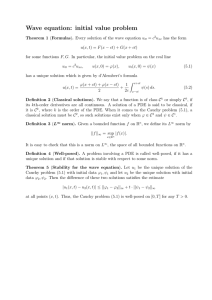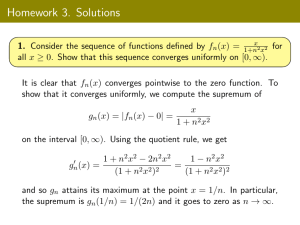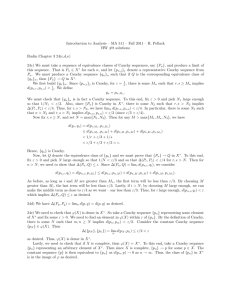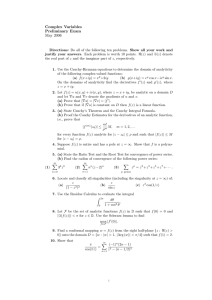Document 10748797
advertisement
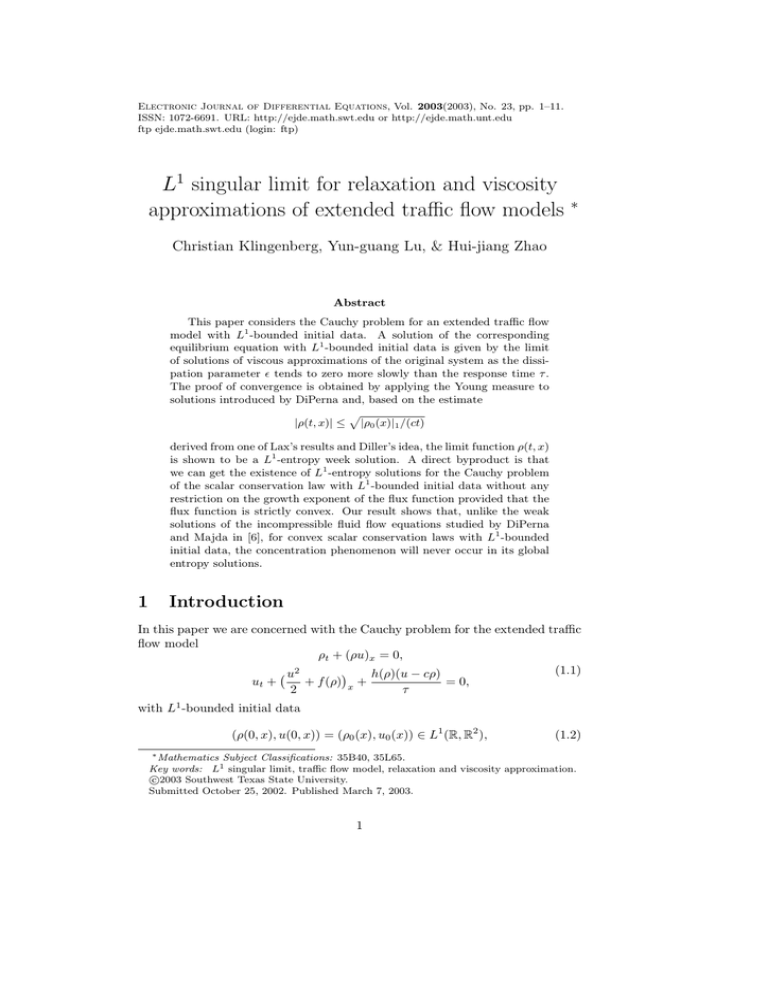
Electronic Journal of Differential Equations, Vol. 2003(2003), No. 23, pp. 1–11.
ISSN: 1072-6691. URL: http://ejde.math.swt.edu or http://ejde.math.unt.edu
ftp ejde.math.swt.edu (login: ftp)
L1 singular limit for relaxation and viscosity
approximations of extended traffic flow models
∗
Christian Klingenberg, Yun-guang Lu, & Hui-jiang Zhao
Abstract
This paper considers the Cauchy problem for an extended traffic flow
model with L1 -bounded initial data. A solution of the corresponding
equilibrium equation with L1 -bounded initial data is given by the limit
of solutions of viscous approximations of the original system as the dissipation parameter tends to zero more slowly than the response time τ .
The proof of convergence is obtained by applying the Young measure to
solutions introduced by DiPerna and, based on the estimate
p
|ρ(t, x)| ≤ |ρ0 (x)|1 /(ct)
derived from one of Lax’s results and Diller’s idea, the limit function ρ(t, x)
is shown to be a L1 -entropy week solution. A direct byproduct is that
we can get the existence of L1 -entropy solutions for the Cauchy problem
of the scalar conservation law with L1 -bounded initial data without any
restriction on the growth exponent of the flux function provided that the
flux function is strictly convex. Our result shows that, unlike the weak
solutions of the incompressible fluid flow equations studied by DiPerna
and Majda in [6], for convex scalar conservation laws with L1 -bounded
initial data, the concentration phenomenon will never occur in its global
entropy solutions.
1
Introduction
In this paper we are concerned with the Cauchy problem for the extended traffic
flow model
ρt + (ρu)x = 0,
2
(1.1)
u
h(ρ)(u − cρ)
ut +
+ f (ρ) x +
= 0,
2
τ
with L1 -bounded initial data
(ρ(0, x), u(0, x)) = (ρ0 (x), u0 (x)) ∈ L1 (R, R2 ),
(1.2)
∗ Mathematics Subject Classifications: 35B40, 35L65.
Key words: L1 singular limit, traffic flow model, relaxation and viscosity approximation.
c
2003
Southwest Texas State University.
Submitted October 25, 2002. Published March 7, 2003.
1
L1 singular limit
2
EJDE–2003/23
where c is a constant and τ denotes the response-time.
The existence of global classical solution of (1.1) was obtained by Schochet
[15] for the case f (ρ) = µτ log ρ under the assumptions that τ is sufficiently small
and τ ≤ µ3+α (α > 0). The zero relaxation limit in the L∞ setting for related
systems of (1.1) was considered in the recent paper [13].
In this paper we show that an L1 -solution of the equilibrium equation
ρt + (cρ2 )x = 0
(1.3)
with L1 -bounded initial data ρ0 (x) can be obtained by the limit of viscous
solutions of the original system (1.1)
ρt + (ρu)x = ρxx ,
h(ρ)(u − cρ)
u
ut +
+ f (ρ) x +
= uxx ,
2
τ
2
(1.4)
as the dissipation parameter and the response-time τ tend to zero, with τ =
o().
For a large class of functions f (ρ) the solutions of the parabolic systems (1.4)
have no a-priori L∞ -estimates which are independent of the viscous parameter even if the initial data are bounded in L∞ and sufficiently smooth. Fortunately
under suitable restrictions on the nonlinear functions f and h, we can get the
following estimates, in which | · |p denotes the norm on Lp and | · |p,q equals
| · |p + | · |q ,
|ρ,τ,m (t, x)|p ≤ M |ρm
p > 1,
(1.5)
0 (x)|1,∞ ,
for solutions (ρ,τ,m (t, x), u,τ,m (t, x)) of the Cauchy problem (1.4) with initial
data
m
(ρ,τ,m (t, x), u,τ,m (t, x))|t=0 = (ρm
(1.6)
0 (x), u0 (x)),
m
where ρm
0 (x), u0 (x), which are smooth functions obtained by smoothing the
initial data (ρ0 (x), u0 (x)) with a mollifier, satisfy
m
1
∞
(ρm
∩ C ∞ (R, R2 ),
0 (x), u0 (x)) ∈ L ∩ L
|ρm
|um
0 (x)|1 ≤ |ρ0 (x)|1 ,
0 (x)|1 ≤ |u0 (x)|1 ,
(1.7)
for any fixed m > 0, and
ρm
0 (x) → ρ0 (x),
1
um
0 (x) → u0 (x) a.e. in L as m → 0.
(1.8)
When and τ tend to zero related by τ = o(), for any fixed m > 0, we can
m
associated to the sequence {ρ,τ,m (t, x)} is
prove that the Young measure ν(t,x)
an entropy measure valued solution of (1.3). Then by applying the results in
m
[16], ν(t,x)
is a Dirac measure and the limit ρm (t, x) of ρ,τ,m (t, x) is the unique
L∞ -entropy solution of the Cauchy problem (1.3) with the initial data ρm
0 (x).
Furthermore, according to the results obtained in [16], we have that such a
EJDE–2003/23 Christian Klingenberg, Yun-guang Lu, & Hui-jiang Zhao
3
solution ρm (t, x) can be obtained as the strong limit of the solution sequence
{ρβ,m (t, x)} to the following Cauchy problem
ρt + cρ2 x = βρxx ,
ρ(t, x)|t=0 = ρm
0 (x),
as β → 0+ . Since ρm
0 (x) satisfies (1.7), we have from the well-known result of
Kruzkov [8] that
Z
Z
m2
1
|ρm1 (t, x) − ρm2 (t, x)|dx ≤
|ρm
(1.9)
0 (x) − ρ0 (x)|dx,
R
R
which means that ρm (t, x) is a Cauchy sequence in L1 .
Note that the flux function cρ2 in (1.3) is a strictly convex function, we have
from the results obtained by Lax in [10] that ρm (t, x) is the almost everywhere
unique minimizer of the functional
Z x+2cv
2
φ(t, x, v) =
ρm
(1.10)
0 (x)dx + cv t.
x
However, since for any fixed point (t, x), φ(t, x, 0) = 0, and
Z
2
φ(t, x, v) ≥ − |ρm
0 (x)|dx + cv t > 0
(1.11)
R
if
r
|ρ0 (x)|1
.
ct
Consequently ρm (t, x) must satisfy the estimate
r
r
|ρm
|ρ0 (x)|1
m
0 (x)|1
|ρ (t, x)| ≤
≤
.
ct
ct
|v| ≥
(1.12)
Thus from (1.9) and (1.12), there exists a function ρ(t, x) ∈ L1loc (R+ × R)
such that ρm (t, x) → ρ(t, x) and the limit function ρ(t, x) is a L1 -entropy solution, in the sense of Szepessy [16] and Diller [4], of the Cauchy problem (1.3)
with L1 -initial data ρ0 (x). Furthermore, following the arguments developed by
Diller in [4], the L1 -entropy weak solution, which satisfies the estimate (1.12),
to the Cauchy problem (1.3) with L1 -initial data ρ0 (x) is unique and depends
continuously in L1 -norm on the initial data and such a uniqueness result guarantees that the whole sequence of {(ρ,τ,m (t, x), u,τ,m (t, x))} converges strongly
to (ρ(t, x), u(t, x)).
In this paper we assume f, h and the initial data (ρ0 (x), u0 (x)) satisfy the
following hypotheses: For q < 4, p < 8 and positive constants c1 . . . c4 we have
A1
f 0 (ρ)
ρ
≥ c1 > c2 , |f 0 (ρ)| ≤ M (1 + |ρ|q );
A2 c2 (1 + |ρ|4 ) ≤ h(ρ) ≤ c3 (1 + |ρ|p );
A3 |ρ0 |1 ≤ c4 , |u0 |1 ≤ c4 ,
4
2
L1 singular limit
EJDE–2003/23
Viscous Solutions
In this section, we consider global existence results for the parabolic system
m
(1.4) with initial data (1.6). Since for any fixed m > 0, (ρm
0 (x), u0 (x)) are
∞
bounded in L , by applying the standard contracting map principle to an
integral representation of (1.4), the local existence of L∞ solutions, for fixed
, τ , to the Cauchy problem (1.4), (1.6) can be easily established.
To extend a local solution to a global solution, we use the the following
a-priori L∞ -estimates.
m
Lemma 2.1 If h(ρ) and f (ρ) satisfy the assumptions A1, A2, (ρm
0 (x), u0 (x))
,τ,m
,τ,m
satisfies (1.7) and the smooth solutions (ρ
(t, x), u
(t, x)) of the Cauchy
problem (1.4), (1.6) exist in [0, T ] × R, then the following estimates hold
|ρ,τ,m (t, x)| ≤ C(T, , τ, m),
|u,τ,m (t, x)| ≤ C(T, , τ, m),
(2.1)
where C(T, , τ, m) is a positive constant depending on T, , τ and m. Furthermore if M1 τ ≤ for a suitable large constant M1 , then
|ρ,τ,m (t, x)|3 ≤ M (m),
|ρ,τ,m (t, x)|1 ≤ |ρ0 (x)|1 ,
(2.2)
where M (m) is a positive constant independent of and τ , but depending on m.
Proof For simplicity, we omit superscripts in (ρ,τ,m (t, x), u,τ,m (t, x)). MulRρ 0
tiplying the first equation in (1.4) by 0 f s(s) ds and the second equation by
u − cρ, then adding the results and integrating on [0, t] × R, we have
Z Z ρZ y 0
Z tZ
1 2
f (s)
h(ρ)(u − cρ)2
u +
ds dy − cρu dx +
dx dt
s
τ
R 2
0
0
0
R
Z tZ f 0 (ρ) 2 (2.3)
+
u2x + 2cρx ux +
ρ dx dt
ρ x
0
R
Z ρm
Z y 0
Z 0
1 m 2
f (s)
m
(u0 ) +
dsdy − cρm
u
≤
0 0 dx.
s
R 2
0
0
Multiplying the first equation in (1.4) by −ρxx and then integrating on [0, t]×R,
we have
Z
Z tZ
1 2
ρx dx + ρ2xx dx dt
R 2
0
R
Z
Z tZ
1 m 2
=
(ρ0x ) dx +
ρxx (ρu)x dx dt
R 2
0
R
Z
Z Z
Z Z
1 m 2
t
2 t
(2.4)
≤
(ρ0x ) dx +
(ρxx )2 dx dt +
|(ρu)x |2 dx dt
2
2
R
0
R
0
R
Z
Z Z
Z tZ
1 m 2
t
1 2
2
≤
(ρ0x ) dx +
(ρxx ) dx dt + |ρ|∞
(ux )2 dx dt
2 0 R
R 2
0
R
Z tZ
1 2
+ |u|∞
(ρx )2 dx dt .
0
R
EJDE–2003/23 Christian Klingenberg, Yun-guang Lu, & Hui-jiang Zhao
Therefore, by (2.3) and A1,
Z
Z tZ
Z
2
2
2
2
2
(ρx ) dx + (ρxx ) dx dt ≤ (ρm
0x ) dx + C() |ρ|∞ + |u|∞ .
0
R
Since
R
Z
2
5
(2.5)
R
x
|ρ| = 2
ρρx dx ≤ |ρ|2 |ρx |2 ≤ C()(1 + |ρ|∞ + |u|∞ ),
(2.6)
−∞
we have
|ρ|∞ ≤ C() 1 + |u|1/2
∞ .
(2.7)
Multiplying the second equation in (1.4) by −uxx and then integrating, we have
Z
Z tZ
1 2
ux dx + u2xx dx dt
0
R
R 2
Z
Z tZ
1 m 2
h(ρ)(u − cρ)uxx
(2.8)
=
(u0x ) dx +
dx dt
τ
R 2
0
R
Z tZ
Z tZ
+
uux uxx dx dt +
f 0 (ρ)ρx uxx dx dt.
0
0
R
R
Due to (2.3) and A2,
Z tZ
h(ρ)(u − cρ)uxx
dx dt
τ
0
R
Z Z
Z tZ
t
1
≤
u2xx dx dt + 2
|h(ρ)|2 (u − cρ)2 dx dt
4 0 R
τ 0 R
Z Z
t
C
≤
u2 dx dt + |h(ρ)|∞
4 0 R xx
τ
Z Z
t
≤
u2 dx dt + C(, τ ) (1 + |ρ|p∞ )
4 0 R xx
Z Z
p t
2
≤
u2xx dx dt + C(, τ ) 1 + |u|∞
,
4 0 R
Z Z
Z tZ
t
uux uxx dx dt ≤
u2xx dx dt + C(, τ ) 1 + |u|2∞
4
0
R
0
R
and
Z Z
Z tZ
t
f 0 (ρ)ρx uxx dx dt ≤
u2 dx dt + C()|f 0 (ρ)|2∞
4 0 R xx
0
R
Z Z
t
u2 dx dt + C() (1 + |u|q∞ ) ,
≤
4 0 R xx
(2.9)
(2.10)
(2.11)
we have
Z
Z tZ
Z
p
2
2
q
2
u2x dx + u2xx dx dt ≤ (um
0x ) dx + C(, τ ) 1 + |u|∞ + |u|∞ + |u|∞ .
R
0
R
R
(2.12)
L1 singular limit
6
EJDE–2003/23
Since
1/2
p
2
u2 ≤ |u|2 |ux |2 ≤ C(, τ ) 1 + |u|2∞ + |u|∞
+ |u|q∞
(2.13)
and p < 8, q < 4, we have by (2.3) and A1,
|u|∞ ≤ C1 (, τ ) < ∞.
Combining the above result with (2.7), we conclude |ρ|∞ ≤ C1 (, τ ). Therefore,
(2.1) is proved.
Now we prove (2.2). Multiplying the first equation in (1.4) by |ρ|ρ and then
integrating, we have
Z tZ
|ρ|3 dx + |ρ|ρ2x dx dt
R
0
R
Z
Z tZ
1
m 3
|ρ | dx +
ρu(|ρ|ρ)x dxdt
=
3 R 0
0
R
Z
Z tZ
Z tZ
1
m 3
=
|ρ | dx +
ρ(u − cρ)(|ρ|ρ)x dx dt + c
(ρ)2 (|ρ|ρ)x dxdt
3 R 0
0
R
0
R
Z
Z tZ
1
=
|ρm |3 dx +
2|ρ|ρ(u − cρ)ρx dxdt
3 R 0
0
R
Z
Z tZ
Z tZ 4
1
ρ (u − cρ)2
m 3
2
≤
|ρ0 | dx + τ
ρx dxdt +
dx dt
3 R
τ
0
R
0
R
τ
≤ M (|ρm
.
0 |1,∞ ) 1 +
(2.14)
So the first estimate in (2.2) is proved. Similarly we can prove the second
estimate which completes the proof of Lemma 2.1.
♦
From the a-priori L∞ estimates (2.1) we can extend the local solution step
by step and get the following global existence theorem.
1
3
Z
Theorem 2.2 If h(ρ), f (ρ) and the initial data satisfy the conditions A1, A2,
and A3, then for any fixed , τ, m satisfying τ = o(), the Cauchy problem (1.4),
(1.6) admits a unique, global smooth solution (ρ,τ,m (t, x), u,τ,m (t, x)) which
satisfies the estimates (2.1), (2.2).
3
Zero Relaxation and Dissipation Limit
In this section, we consider the convergence of solutions (ρ,τ,m (t, x), u,τ,m (t, x))
to the Cauchy problem (1.4), (1.6) as the dissipation parameter and the response time τ tend to zero. We show that a L1 -solution of (1.3) with L1 -bounded
initial data ρ0 (x) can be given by the limit of ρ,τ,m (t, x) as +τ +m → 0+. The
technique to prove the strong convergence is to employ the concept of entropy
measure valued solution to (1.3) with initial data ρm
0 (x) introduced by DiPerna
[5].
EJDE–2003/23 Christian Klingenberg, Yun-guang Lu, & Hui-jiang Zhao
7
m
We show that the Young measure ν(t,x)
associated with {ρ,τ,m (t, x)} is an
entropy measure valued solution of (1.3) with initial data ρm
0 (x). Then by
m
applying the results given in [16], we get that ν(t,x)
is a Dirac measure and the
limit function ρm (t, x) of {ρ,τ,m (t, x)} as , τ tend to zero related by τ = o()
is the unique L3 -entropy solution of (1.3) with the initial data ρm
0 (x). To prove
that the limit function ρ(t, x) of ρm (t, x) as m tends to zero is a L1 -solution of
(1.3) with the initial data ρ0 (x), we need the following results of Lax
Lemma 3.1 ([10]) Let u(t, x) be the entropy solution of the Cauchy problem
for the scalar conservation law
ut + (cu2 )x = 0,
u(t, x)|t=0 = u0 (x) ∈ L1 ∩ L∞ .
(3.1)
obtained by Kruzkov in [8]. Then u(t, x) is the almost everywhere unique minimizer of the functional
Z
x+2cv
u0 (x)dx + cv 2 t.
φ(t, x, v) =
(3.2)
x
If ρm (t, x) is the L1 ∩L∞ -entropy solution for the equation (1.3) with L1 ∩L∞
initial data ρm
0 (x), then from Lemma 3.1 and Diller’s result in [4], we have
r
r
|ρ0 (x)|1
|ρm
m
0 (x)|1
.
(3.3)
≤
|ρ (t, x)| ≤
ct
ct
In fact, we have that for any fixed point (t, x), φ(t, x, 0) = 0, and
Z
2
φ(t, x, v) ≥ − |ρm
0 (x)|dx + cv t > 0
R
p
if |v| ≥ |ρm
0 (x)|1 /(ct), and as an immediate consequence, we have that (3.3)
holds almost everywhere.
m
Theorem 3.2 The Young measure ν(t,x)
associated to the sequence {ρ,τ,m (t, x)}
is an entropic measure valued solution of the Cauchy problem (1.3) with the initial data ρm
0 (x).
Proof It is sufficient to prove the following two estimates [16]:
∂ m
∂ m
hν(t,x) (λ), |λ − k|i +
hν
(λ), sign(λ − k)(cλ2 − ck 2 )i ≤ 0
∂t
∂x (t,x)
(3.4)
for all k ∈ R1 in the sense of distributions, and
1
lim
T →0+ T
Z
0
T
Z
I
m
hν(t,x)
(λ), |λ − v0 (x)|i dx dt = 0
(3.5)
L1 singular limit
8
EJDE–2003/23
for any compact interval I ∈ R. Since the function |ρ − k| can be approximated
by smooth bounded convex functions η(ρ) whose first and second derivatives
are bounded in R, the following inequality with the Young measure representing
weak limit theorem [5, 16] will give the proof of (3.4):
η(ρ,τ,m )t + q(ρ,τ,m )x ≤ 0
(3.6)
in the sense of distributions, where q(ρ) is a entropy flux of (1.3) corresponding
to η(ρ). For brevity, we will omit the superscripts , τ and m in the following.
To prove (3.6), multiplying the first equation in (1.4) by η 0 (ρ), we have
η(ρ)t + q(ρ)x
= −η 0 (ρ)(ρ(u − cρ))x + η 0 (ρ)ρxx
0
00
= −(η (ρ)ρ(u − cρ))x + η (ρ)ρ(u − cρ)ρx − η
(3.7)
00
(ρ)ρ2x
+ ηxx (ρ).
From estimates in (2.4) and τ = o(), we have that
Z Z
|ρη 00 (ρ)(u − cρ)ρx | dx dt
Ω
1/2 Z Z τ ρ2 ρ2
1/2
Z Z h(ρ)(u − cρ)2
x
dx dt
dx dt
→ 0,
≤M
τ
Ω
Ω h(ρ)
(3.8)
and
Z Z
(η 0 (ρ)ρ(u − cρ))x φ dx dt
ZΩ Z
=
η 0 (ρ)ρ(u − cρ)φx dx dt
Ω
1/2 Z Z h(ρ)(u − cρ)2
1/2
Z Z τ ρ2 φ2
x
dx dt
dx dt
→0
≤M
τ
Ω
Ω h(ρ)
(3.9)
as τ = o() and tends to zero for any compact set Ω in R × R+ . Moreover since
η 00 (ρ) ≥ 0, and η(ρ)xx → 0 in the sense of distributions, then (3.6) is proved
by letting → 0 in (3.7).
The proof of (3.5) can be obtained as in [16]; thus we omit the details. This
completes the proof of Theorem 3.2.
♦
Now we give the main result in this section.
Theorem 3.3 If h(ρ), f (ρ) and the initial data satisfy the conditions A1-A3,
then the whole solution sequence of (ρ,τ,m (t, x), u,τ,m (t, x)) to the Cauchy problem (1.4), (1.6) converges pointwise almost everywhere
(ρ,τ,m (t, x), u,τ,m (t, x)) → (ρ(t, x), u(t, x))
as m, and τ tend to zero whose relation are given by τ = o(). Here the limit
functions (ρ(t, x), u(t, x)) satisfy
1. u(t, x) = cρ(t, x) for almost all (t, x) ∈ R+ × R and
2. ρ(t, x) is the unique L1 -entropy solution of the Cauchy problem (1.3) with
L1 -bounded initial data ρ0 (x), which satisfies the estimate (3.3).
EJDE–2003/23 Christian Klingenberg, Yun-guang Lu, & Hui-jiang Zhao
9
Proof From Theorem 3.2 and the results obtained in [16], we conclude that
m
ν(t,x)
= δρm (t,x) ,
a. e.,
From Lemma 2.1, there exists a subsequence {ρk ,τk ,m (t, x)} of {ρ,τ,m (t, x)}
such that
ρk ,τk ,m (t, x) → ρm (t, x)
in L1 (R+ × R) as k + τk → 0+
(3.10)
provided τk = o(k ). One can easily verify that ρm (t, x) is a L∞ -entropy week
solution, in the sense of [16], to (1.3) with initial data ρm
0 (x).
On the other hand, (2.3) and A2 imply
Z tZ
lim
|uk ,τk ,m (t, x) − cρk ,τk ,m (t, x)| dx dt = 0
(3.11)
k +τk →0+
0
R
which means that there exists a function um (t, x) = cρm (t, x) such that
uk ,τk ,m (t, x) → um (t, x)
in L1 (R+ × R)
as k + τk → 0+ .
(3.12)
Furthermore, by employing the results obtained in [16] again, we have that
the solution ρm (t, x) obtained above can be obtained as the strong limit of the
solution sequence {ρβ,m (t, x)} to the following Cauchy problem
ρt + cρ2 x = βρxx ,
ρ(t, x)|t=0 = ρm
0 (x),
1
∞
as β → 0+ . Since ρm
0 (x) ∈ L ∩ L , we have from the well-known result of
Kruzkov [8] that
Z
Z
m1
2
|ρm2 (t, x) − ρm1 (t, x)|dx ≤
|ρm
(3.13)
0 (x) − ρ0 (x)|dx,
R
R
and from the discussions after Lemma 3.1, ρm (t, x) must satisfy the estimate
(3.3). Consequently
ρm (t, x) → ρ(t, x) in L1 (R+ × R),
(3.14)
and ρ(t, x) satisfies
r
|ρ0 (x)|1
.
(3.15)
ct
Diller’s results in [4] show that ρ(t, x) is a L1 -entropy weak solution of (1.3) with
L1 -bounded initial data ρ0 (x) in the sense of Kruzkov [8]. So the first assertion
of Theorem 3.3 is easy to be verified by (3.11), (3.12) and (1.8).
To conclude that the whole sequence of {(ρ,τ,m (t, x), u,τ,m (t, x))} converges
almost everywhere to (ρ(t, x), u(t, x)), we need only to prove the uniqueness
of the L1 -entropy weak solution ρ(t, x), which satisfies (3.15), to the Cauchy
problem (1.3) with L1 -bounded initial data ρ0 (x). Due to the estimate (3.15),
such a result follows from the same arguments developed by Diller in [4]. This
completes the proof of Theorem 3.3.
|ρ(t, x)| ≤
10
L1 singular limit
EJDE–2003/23
Acknowledgments The authors are grateful to the referees for their carefully
reading the original manuscript and for their valuable suggestions. The authors
were partially supported by a grant from National University of Colombia, by
grants 10071080 and 10041003 of NNSF China.
References
[1] I.-L. Chern, Long-time effect of relaxation for hyperbolic conservation laws,
Comm. Math. Phys. 172 (1995), 39-55.
[2] G.-Q. Chen, C.D. Levermore, T.-P. Liu, Hyperbolic conservation laws with
stiff relaxation terms and entropy, Comm. Pure Appl. Math. 47 (1994),
787-830.
[3] G.-Q. Chen, T.-P. Liu, Zero relaxation and dissipation limits for hyperbolic
conservation laws, Comm. Pure Appl. Math. 46 (1993), 755-781.
[4] D. J. Diller, A note on the uniqueness of entropy solution to first order
quasilinear equations, Electronic J. of Differential Equations 5 (1994), 1-4.
[5] R. J. DiPerna, Measure-valued solutions to conservation laws, Arch. Rational Mech. Anal. 88 (1995), 223-270.
[6] R. J. DiPerna and A. Majda, Oscillations and concentrations in weak solutions of the incompressible fluid equations, Comm. Math. Phys. 108 (1987),
667-689.
[7] C. Klingenberg, Y.-G. Lu, Cauchy problem for hyperbolic conservation laws
with a relaxation term, Proc. Roy. Soc. of Edinb. 126A (1996), 821-828.
[8] S. N. Kruzkov, First order quasilinear equations in several independent
variables, Mat. SB.(N.S.) 81 (1970), 228-255.
[9] C. Lattanzio and P. Marcati, The zero relaxation limit for the hydrodynamic Whitham traffic flow model, J. Differential Equations 141 (1997),
150-178.
[10] P. D. Lax, Hyperbolic systems of conservation laws and the mathematical
theory of shock waves, SIAM, Philadelphia, 1973.
[11] Y.-G. Lu and C. Klingenberg, The Cauchy problem for hyperbolic consedvation laws with three equations, J. Math. Appl. Anal. 202 (1996), 206-216.
[12] Y.-G. Lu and C. Klingenberg, The relaxation limits for systems of Broadwell type, Differential and Integral Equations 14 (2001), 117-127.
[13] Y.-G. Lu, Singular Limits of Stiff Relaxation and Dominant Diffusion for
Nonlinear Systems, J. Differential Equations 179 (2002), 687-713.
EJDE–2003/23 Christian Klingenberg, Yun-guang Lu, & Hui-jiang Zhao
11
[14] Y.-G. Lu, Hyperboilc Conservation Laws and the Compensated Compactness Method, CRC Press, USA, 2002.
[15] S. Schochet, The instant-response limit in Whitham’s nonlinear traffic-flow
model: Uniform well-posedness and global existence, Asymptotic Analysis
1 (1988), 4: 263-282.
[16] A. Szepessy, An existence result for scalar conservation laws using measure
valued solutions, Commun. Partial Differential Equations 14 (1989), 13291350.
[17] G. B. Whitham, Linear and Nonlinear Waves, John Wiley and Sons, 1973.
[18] Huijiang Zhao, A note on the Cauchy problem to a class of nonlinear dispersive equations with singular initial data, Nonlinear Analysis, TMA 42
(2000), 251-270.
Christian Klingenberg
Department of Mathematicas, Würzburg University
Würzburg, 97074, Germany
e-mail: klingen@mathematik.uni-wuerzburg.de
Yun-guang Lu
Department of Mathematics
University of Science and Technology of China, Hefei, China
and
Departamento de Matemáticas
Universidad Nacional de Colombia, Bogota, Colombia
e-mail: yglu@matematicas.unal.edu.co
Hui-jiang Zhao
Institute of Physics and Mathematicas
Chinese Academy of Sciences, Wuhan, China
e-mail: hjzhao@wipm.whcnc.ac.cn


